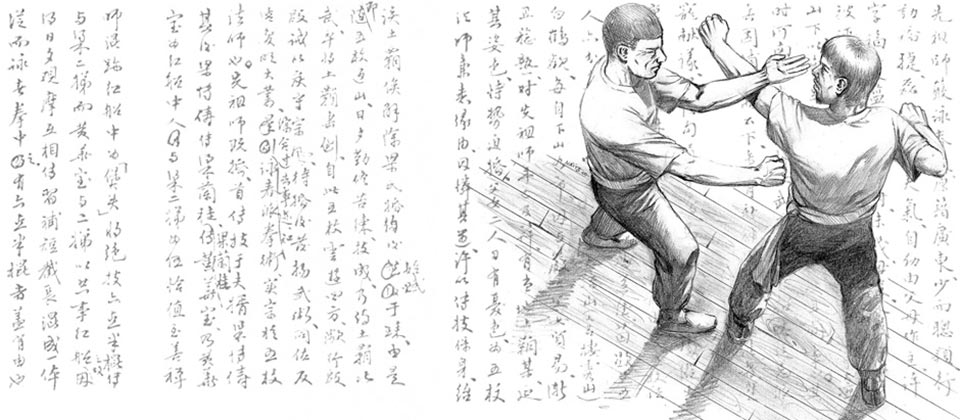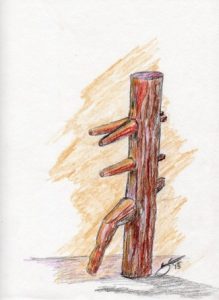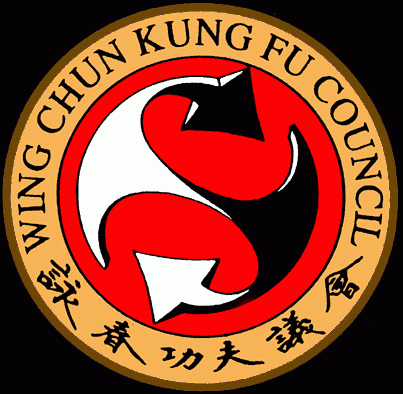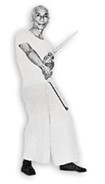
.
Wing Chun Kuen is not so much a particular martial art style as it is a method, a training system, to build a body structure within the practitioner that is most suited to martial purpose. The premise for this is that the system is based on natural human body motion and the techniques are built around a set of fundamental principles from which the system draws its power. Form training then becomes the study of human body structure (skeleton and musculature) and its mechanics. The result of such training will be the building up of a highly efficient martial structure within one’s body.
Wing Chun Concepts Curriculum
The Wing Chun Concepts curriculum consists of three primary elements, Structural Development Forms, or simply Forms, Reflex Development Drills, or Drills, and Tactical Development Drills, or Tactics. There are also two supplementary elements, Weapon Training and Equipment Training.
All of the Wing Chun techniques are first learned from the Forms and Drills. These sequences provide a safe and effective way to practice and polish the skills. It is important to note that the intent, focus, content and sequence of movements for both Forms and Drills can change from lineage to lineage, or even from school to school. The most common curriculum framework includes three empty hand forms, one wooden dummy form and two weapons forms. The Drill progression generally moves from basic blocks, strikes and trapping to various forms of sticking-hands and sticking-legs (chi sau and chi gerk) drills, and finally to pre-arranged and then free-form sparring.
Tactics are a modern evolution of traditional (gwoh sau and maai saan jong) combat sparring. Tactical drills pair Wing Chun technique with Real World situations to create a laboratory for problem solving. Tactics are used to incrementally prepare students for sparring and to test the legitimacy of Wing Chun technique. Tactics may be trained against one or more attackers, with or without weapons present, and you may be defending from a standing position, be pinned against a wall, be seated, or be flat on the ground. Tactical drills often use modern training equipment such as focus mitts, Muay Thai pads and kicking shields.
In this page, there is an overview of the entire Wing Chun Concepts curriculum. It follows a strict linear progression where every completed step in the syllabus builds a foundation for the next. This allows the body to learn, adapt and integrate the techniques until they can be expressed reflexively without conscious thought. The progression also takes into account the changes and transformation in both body and mind. Command and Mastery of each step creates an ever-growing comprehension of the principles and concepts.
Forms are solo exercises which develop focus, balance, proprioception and kinesthetic awareness. The forms introduce the hand positions, techniques and defining movements of each progressive level of Wing Chun and provide a way to practice without a partner.
Students begin their Forms training by learning the gross mechanical movements, simply learning the “choreography” of the sequence. Once they have the pattern, they begin to carefully refine the structural precision of each movement. They gain a clear awareness of the chains of movement, their shifting balance, and the functional importance of each technique. As they progress, students will develop a sense of flow, control both tension and relaxation, and understand force generation.
Siu Lim Tau – 小念頭: The Little Idea
The first and most important form in Wing Chun is Siu Lim Tau, or “The Little Idea.” This is the foundation upon which all of the other forms and techniques are developed. In just this one form, the student is introduced to Centerline Theory, Wing Chun punching, the Yee Jee Kim Yung Ma training stance, the principles of Elbow Power, and a variety of hand techniques, including the three poison hands of Wing Chun: Tan, Bong, and Fook.
Again, meaning ‘Little Idea Form’. This 1st form introduces the beginner to the basics, such as stance and hand-techniques as well as theories and principles of Wing Chun Kuen. Siu Lim Tao builds the foundation for the whole system.
Forms are solo exercises which develop focus, balance, proprioception and kinesthetic awareness. The forms introduce the hand positions, techniques and defining movements of each progressive level of Wing Chun and provide a way to practice without a partner.
Students begin their Forms training by learning the gross mechanical movements, simply learning the “choreography” of the sequence. Once they have the pattern, they begin to carefully refine the structural precision of each movement. They gain a clear awareness of the chains of movement, their shifting balance, and the functional importance of each technique. As they progress, students will develop a sense of flow, control both tension and relaxation, and understand force generation.
Chum Kiu – 尋橋: Seeking the Bridge
The second form in Wing Chun is Chum Kiu, or “Seeking the Bridge.” It is typically considered the most difficult of the three forms to learn, but is also the most popular. Chum Kiu focuses on controlled, coordinated movement of the entire body and generating power through rapid twisting motions. In Siu Lim Tau, the hands merely have to occupy the centerline. In Chum Kiu, you have to turn and move your centerline while maintaining your balance. Chum Kiu also introduces the first elbow and kicking techniques.
meaning ‘Searching the Bridge’. The 2nd form teaches the practitioner how to apply the hand-techniques of the 1st form in coordination with footwork. – Wing Chun Kuen becomes applicable.
Forms are solo exercises which develop focus, balance, proprioception and kinesthetic awareness. The forms introduce the hand positions, techniques and defining movements of each progressive level of Wing Chun and provide a way to practice without a partner.
Students begin their Forms training by learning the gross mechanical movements, simply learning the “choreography” of the sequence. Once they have the pattern, they begin to carefully refine the structural precision of each movement. They gain a clear awareness of the chains of movement, their shifting balance, and the functional importance of each technique. As they progress, students will develop a sense of flow, control both tension and relaxation, and understand force generation.
Biu Jee – 鏢指; Standard Compass
The third form in Wing Chun is Biu Jee, or “Standard Compass.” This form is comprised of extreme short-range and extreme long-range techniques, low kicks and sweeps, and “emergency techniques” to recover and respond when structure has seriously compromised. Biu Jee was designed to train the hands to return to centerline and the body to recover to balance, even from extreme angles and awkward positions — just as the compass needle always returns to North after any movement.
meaning ‘Shooting Fingers’. The 3rd form involves more sophisticated hand-techniques, elbow-strikes for close-quarter fighting and additional footwork. Biu Jee is regarded as an ‘emergency form’.
Mook Yan Jong – 木人樁; Wooden Dummy
The most famous and most 
meaning ‘Wooden Man Post’. It teaches correct application of the 3 empty-hand forms. In addition the student learns about timing, distancing and the proper application of power in regards to direction and angles. The wooden dummy is an extremely valuable tool for the accurate execution of the Wing Chun techniques and overall improvement.
Weapons Training
Once the student has mastered the ability to generate and utilize Jing or force in the open hand forms, they can progress to the Wing Chun weapons training. The three empty-hand forms train to deliver force to the end of the finger tips. With weapons training, the student is taught to extend that force through the weapon as an extension of the body. The weapon forms are also considered as an advanced form of conditioning training for the hands, wrists and forearms.
Baat Jaam Do – 八斬刀; Eight Slashing Knives
The Baat Jaam Do knife form utilizes a pair of large “Butterfly Knives.” The knives are shorter that the common Chinese short sword (Dao), but larger than the Willow Leaf knife used by the drummer in Chinese lion dancing. Historically the knives were also referred to as Dit Ming Do, or “Life-Taking Knives.” There are two stories about where Baat Jaam Do got its name: one from the knife form having eight sections, another from there being eight slashing cuts in the first section of the form.
Luk Dim Boon Kwan – 六點半棍; Six and A Half Point Pole
The Luk Dim Boon Kwan is a tapered wooden pole ranging anywhere from eight to thirteen feet in length. The pole trains seven key principles: Tai (uprooting), Lan (expansion), Dim (shock), Kit (deflect), Got (cut down), Wan (circle), and Lau (flowing). These same principles are used throughout the unarmed forms of Wing Chun as well. The name six and a half point pole comes from these seven principles, with the last principle – Flowing – counting as half a point.
Xiandai Wuqi – 现代武器; Modern Weapons: Stick, Knife, Gun
While not strictly traditional, the Wing Chun Concepts course explores how to apply all of the concepts and principles of Wing Chun to the most common weapons used in the modern world: impact weapons like sticks and batons, edged weapons like fixed blade or folding knives, and revolvers or semi-automatic handguns. This training uses a simple matrix of weapon/counter-weapon tactics (ie, hand vs stick, stick vs stick, stick vs knife, etc), all while seeking Wing Chun efficiency and economy of motion.






